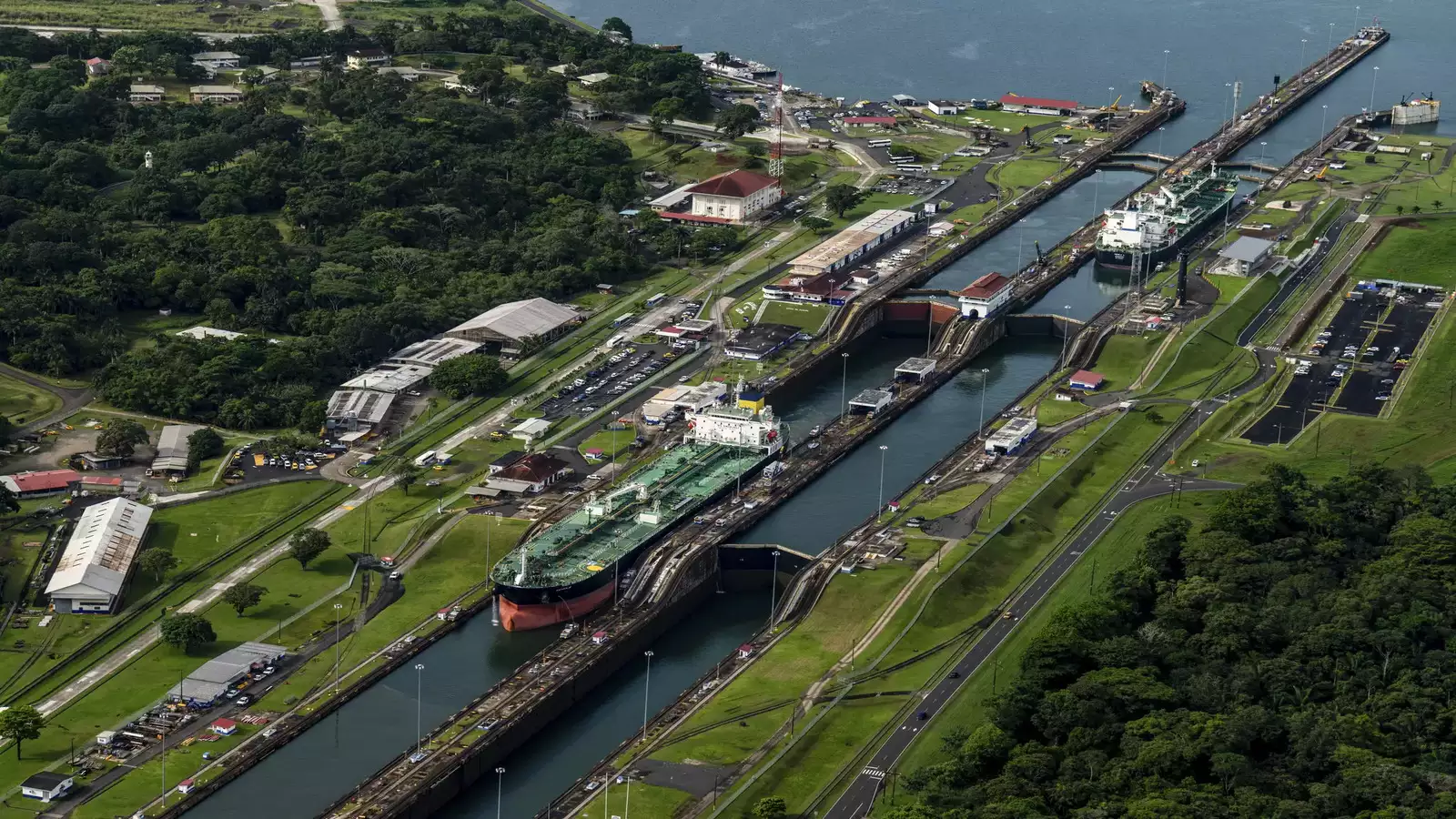
What is Panama Canal ?
Panama Canal, lock-type canal, owned and administered by the Republic of Panama, that connects the Atlantic and Pacific oceans through the narrow Isthmus of Panama. The length of the Panama Canal from shoreline to shoreline is about 40 miles (65 km) and from deep water in the Atlantic (more specifically, the Caribbean Sea) to deep water in the Pacific about 50 miles (82 km). The canal, which was completed in August 1914, is one of the two most strategic artificial waterways in the world, the other being the Suez Canal. Ships sailing between the east and west coasts of the United States, which otherwise would be obliged to round Cape Horn in South America, shorten their voyage by about 8,000 nautical miles (15,000 km) by using the canal. Savings of up to 3,500 nautical miles (6,500 km) are also made on voyages between one coast of North America and ports on the other side of South America. Ships sailing between Europe and East Asia or Australia can save as much as 2,000 nautical miles (3,700 km) by using the canal.
From its opening in 1914 until 1979, the Panama Canal was controlled solely by the United States, which built it. In 1979, however, control of the canal passed to the Panama Canal Commission, a joint agency of the United States and the Republic of Panama, and complete control passed to Panama at noon on December 31, 1999. Administration of the canal is the responsibility of the Panama Canal Authority (Spanish: Autoridad del Canal de Panamá [ACP]), which answers solely to the government of Panama.
Physical features
The canal

The Panama Canal lies at a latitude of 9° N, at a point where the North American Continental Divide dips to one of its lowest points. The canal does not, as is generally supposed, cross the isthmus from east to west. It runs due south from its entrance at Colón on the Atlantic side through the Gatún Locks to a point in the widest portion of Gatún Lake; it then turns sharply toward the east and follows a course generally to the southeast until it reaches the Bay of Panama, on the Pacific side. Its terminus near Balboa is some 25 miles (40 km) east of its terminus near Colón. Parallel to the canal are the Panama Canal Railway and the Boyd-Roosevelt Highway.
In passing from the Atlantic to the Pacific, vessels enter the approach channel in Limón Bay, which extends a distance of about 7 miles (11 km) to the Gatún Locks. At Gatún a series of three locks lifts vessels 85 feet (26 metres) to Gatún Lake. The lake, formed by Gatún Dam on the Chagres River and supplemented by waters from Alajuela Lake (Lake Madden; formed by the Madden Dam), covers an area of 166 square miles (430 square km). The channel through the lake varies in depth from 46 to 85 feet (14 to 26 metres) and extends for about 23 miles (37 km) to Gamboa. Gaillard (Culebra) Cut begins at Gamboa and passes through the Continental Divide.
The channel through the cut has an average depth of about 43 feet (13 metres) and extends some 8 miles (13 km) to the Pedro Miguel Locks. The locks lower vessels 30 feet (9 metres) to Miraflores Lake, at an elevation of 52 feet (16 metres) above sea level. Vessels then pass through a channel almost 1.2 miles (2 km) long to the two-stepped locks at Miraflores, where they are lowered to sea level. The final segment of the canal is a dredged approach passage 7 miles long through which ships pass into the Pacific. Throughout its length the canal has a minimum bottom width of 500 feet (150 metres); in Gatún Lake the width of the channel varies between 500 and 1,000 feet (150 and 300 metres), and in Miraflores Lake the width is 740 feet (225 metres).
Locks

The canal locks operate by gravity flow of water from Gatún, Alajuela, and Miraflores lakes, which are fed by the Chagres and other rivers. The locks themselves are of uniform length, width, and depth and were built in pairs to permit the simultaneous transit of vessels in either direction. Each lock gate has two leaves, 65 feet (20 metres) wide and 6.5 feet (2 metres) thick, set on hinges.
The gates range in height from 46 to 82 feet (14 to 25 metres); their movement is powered by electric motors recessed in the lock walls. They are operated from a control tower, which is located on the wall that separates each pair of locks and from which the flooding or emptying of the lock chambers is also controlled. The lock chambers are 1,000 feet (300 metres) long, 110 feet (33 metres) wide, and 40 feet (12 metres) deep.
Because of the delicate nature of the original lock mechanisms, only small craft are allowed to pass through the locks unassisted. Larger craft are guided by electric towing locomotives, which operate on cog tracks on the lock walls and serve to keep the ships centred in the lock. Before a lock can be entered, a fender chain, stretched between the walls of the approach, must be passed. If all is proceeding properly, that chain will be dropped into its groove at the bottom of the channel.
If by any chance the ship is moving too rapidly for safety, the chain will remain stretched and the vessel will run against it. The chain, which is operated by hydraulic machinery in the walls, then will pay out slowly by automatic release until the vessel has been brought to a stop. If the vessel should get away from the towing locomotive and, breaking through the chain, ram the first gate, a second gate 50 feet (15 metres) away will protect the lock and arrest further advance.
The third lock systems of the Third Set of Locks Project, begun in 2007, were inspired by the Berendrecht lock in Antwerp, Belgium, and water-saving basins used in canals in Germany. Some 190,000 tons of steel, mostly from Mexico, are entrenched in heavily reinforced concrete to build the lock chambers on the Atlantic and Pacific sides, and the new lock gates measure up to 33 feet (10 metres) wide, 98 feet (30 metres) high, and 190 feet (58 metres) long.
The new chambers and basins, which will control the water flowing from Gatún Lake, were designed to minimize the turbulence of water flow and the disturbance to transiting vessels. The basins were completed in June 2016 and include 158 valves consisting of 20,000 tons of structural material. Officials say those water-saving basins are the largest in the world and facilitate a 60 percent reuse of water. Whereas the existing locks use 52 million gallons (197 million litres) with each use, the new locks use 48 million gallons (182 million litres).
Breakwaters
Long breakwaters have been constructed near the approach channels in both oceans. Breakwaters extend from the west and east sides of Limón Bay; the west breakwater protects the harbour against severe gales, and the east one reduces silting in the canal channel. On the Pacific side a causeway extends from Balboa to three small islands (Naos, Perico, and Flamenco) and diverts crosscurrents that carry soft material from the shallow harbour of Panama City into the canal channel.
Operation
Navigation
Ships are taken through the canal by one or more pilots, who board each ship before it leaves the terminus. With waiting time, ships may require about 25 hours to negotiate the canal. The average transit time, once a vessel has been authorized to proceed, is about 10 hours from one end of the canal to the other. When Gaillard (Culebra) Cut is not being dredged, canal traffic generally proceeds in both directions. The heavy rainfall of Panama makes operation feasible despite the irrevocable loss of large quantities of water with each transit. To conserve water, two or more vessels moving in the same direction are passed through together when their sizes permit.
Each ship is also boarded by measurers to verify its carrying capacity and to collect tolls. Manifests, ships’ papers, and other documents are inspected and recorded. Transits are scheduled and monitored at points along the route by an automated marine traffic control system.
Maintenance

Continual maintenance work on the canal and its associated facilities is needed to keep it in operation in a tropical climate. That includes dredging channels, scheduling overhauls of locks, and repairing and replacing machinery. Because of heavy rainfall and unstable soils, landslides in the hills adjoining Gaillard Cut have been an intermittent problem since the canal was built. Preventive and remedial measures frequently have been taken to keep the channel open, and a program to stabilize its banks was designed to draw away rainfall that might otherwise undercut its slopes. Two major slides have occurred since 1970, the first in 1974 and the second in 1986; in both cases one-way traffic had to be imposed for a time in the affected area.
Another serious problem threatening the canal has been the increased silting and sedimentation rate of the rivers and streams of the watershed and, ultimately, of the canal itself. That degradation has been caused by the slash-and-burn agricultural techniques practiced by local migratory farmers. Although the canal watershed was still completely forested in the early 1950s, by the late 1970s it had been reduced by nearly 70 percent. Measures to control soil erosion have been undertaken by the governments of both the United States and Panama.
Canal traffic
Traffic through the Panama Canal is a barometer of world trade, rising in times of world economic prosperity and declining in times of recession. From a low of 807 transits in 1916, traffic rose to a high point of 15,523 transits of all types in 1970. The cargo carried through the canal that year amounted to more than 132.5 million long tons (134.6 million metric tons). Although the number of annual transits has decreased since then, the canal carries more freight than ever before because the average size of vessels has increased. There were nearly 210 million long tons (213 million metric tons) of cargo through the canal in 2013.
The principal trade routes served by the Panama Canal run between the following points: the east coast of the U.S. mainland and Hawaii and East Asia; the U.S. east coast and the west coast of South America; Europe and the west coast of North America; Europe and the west coast of South America; the east coast of North America and Oceania; the U.S. east and west coasts; and Europe and Australia.
Trade between the east coast of the United States and East Asia dominates international canal traffic. Among the principal commodity groups carried through the canal are motor vehicles, petroleum products, grains, and coal and coke.
Panama Canal Authority
The Panama Canal Authority (Spanish: Autoridad del Canal de Panamá [ACP]) took over management of the canal from the joint U.S.-Panamanian Panama Canal Commission at noon on December 31, 1999. Created by an amendment to the Panamanian constitution as an autonomous agency of the Panamanian government, the ACP is charged with the administration, operation, conservation, maintenance, and modernization of the Panama Canal. It is also tasked with the care, maintenance, and preservation of water resources in the entire Panama Canal watershed. The watershed is essential to the operation of the canal, and it also supplies water to cities at either end of the canal route.
The ACP is governed by a board of directors that consists of 11 members. The chairman, who has the rank of minister of state for canal affairs, is selected by the president of the republic. The legislative branch of the government designates one director, and the remaining nine members are appointed by the president with the concurrence of the cabinet council. They must be ratified by an absolute majority of the legislative assembly.
Tolls
While the canal was under U.S. administration, tolls for its use were set at rates calculated to cover costs of maintenance and operation, thereby making the canal self-financing. The charge for each transit was based upon the interior cargo or passenger-carrying capacity of a vessel. The rates established in 1914 remained virtually unchanged for 60 years. In 1973 the canal operated at a loss for the first time, and in 1974 the first of several rate increases went into effect.
Traditionally, cargoes were carried below deck, and tolls were assessed on goods carried there. However, because of changes in marine design and the widespread use of containerized cargoes, a large portion of the burden is now carried on deck. The volume of containerized cargo passing through the canal is outranked only by shipments of grain and petroleum products. Those changes led to modifications in rules of admeasurement and the assessment of tolls for on-deck container capacity, and a segmentation system based on vessel type and size was implemented. Following the lead of the Panama Canal Commission, the ACP approved similar changes in admeasurement regulations and retained the U.S. toll rates in effect when the canal was transferred.
In 2006 the ACP announced that its expansion programs would be financed by a new series of toll increases, sparking much debate and opposition from canal users. It was not until 2012 that the cabinet council approved a proposal to restructure the Panama Canal’s pricing system, and the two stages of the toll increase were implemented in October 2012 and October 2013. The new toll structure increased the number of segments from 8 to 10. The tanker segment was separated into three segments: petroleum and petroleum products tankers, gas vessels carrying liquefied petroleum gas (LPG), and chemical vessels. Roll-on/roll-off (ro-ro) vessels, which are designed to carry wheeled cargo, became part of the vehicle carrier segment, and the container/break-bulk segment was eliminated. Tolls for general cargo, dry bulk, tanker, chemical tanker, LPG, and vehicle carrier and ro-ro were increased.
From the tolls collected, the ACP must pay an annual fee to the Panamanian national treasury. Any surplus remaining after that and the payment of canal operational and maintenance expenses also goes to the treasury.
Reference: www.britannica.com




Love you, Lwin lay 😘❤️
VERY USEFUL 😀
Thanks for sharing knowledge ❤️
Well noted
Panama Canal is one of the human achievements.It beckons us to recognise the urgency of environmental protection .
Great, thanks for sharing.
Arrived
Good morning all guys ❤️🌞
Old but Gold song 😻🎧
Big gratitude to C4A for both knowledgeable articles and nice song 🎵
Thank a lot of your sharing PANAMA CANAL. Great song. .😍Miss you 🍓
Really informative, thank you for reading such a diverse and comprehensive article.
Thank you for sharing and good music.
Thanks for sharing.
Done ✅
Morning🌸
Hello 👋
Thanks infinity ♾️ for knowledge about Panama canal!